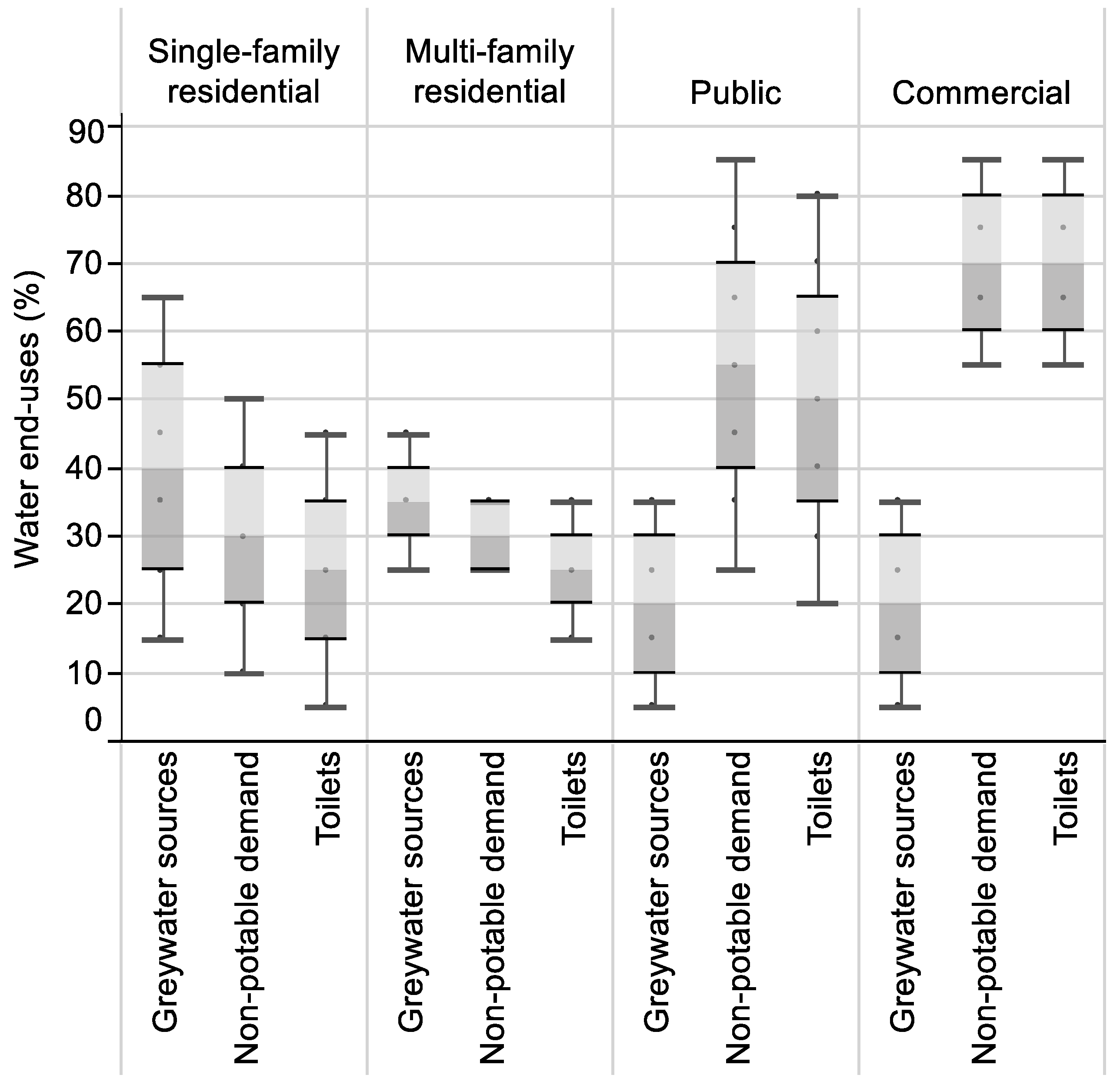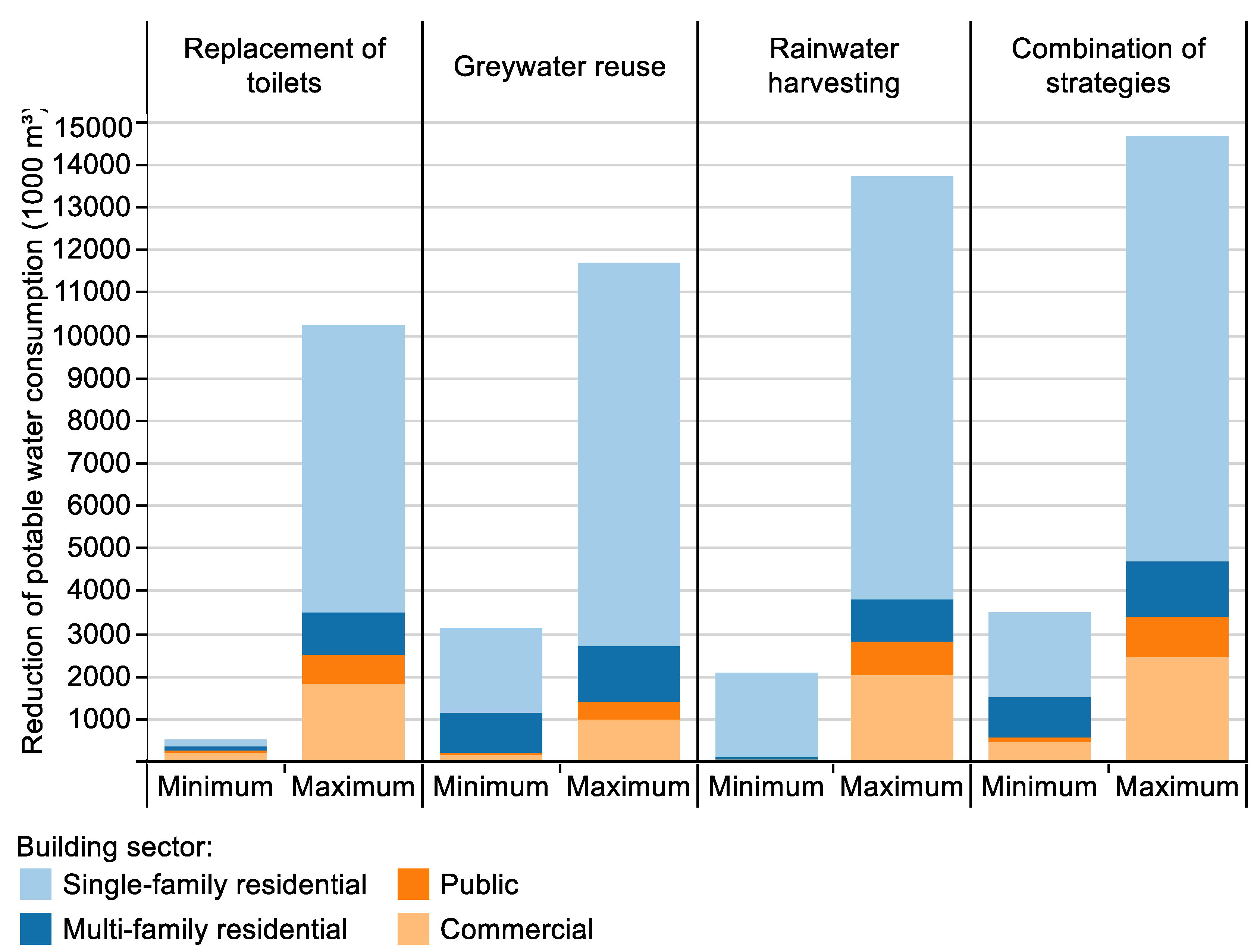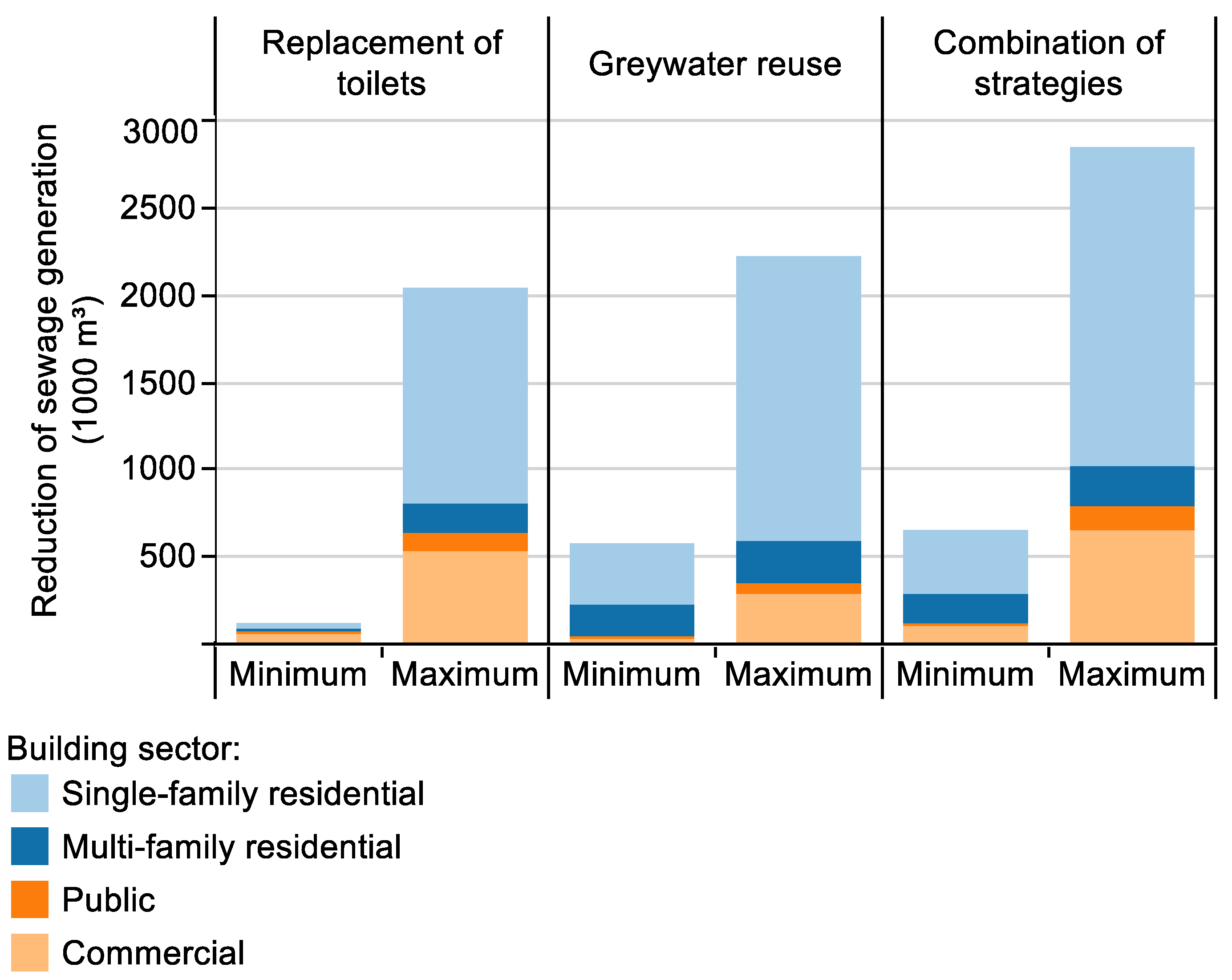Reduction of Potable Water Consumption and Sewage Generation on a City Scale: A Case Study in Brazil
Abstract
1. Introduction
2. Methods
2.1. Study Area
2.2. Water End-Uses
2.3. Potential for Potable Water Savings
2.3.1. Replacement of Toilets
2.3.2. Greywater Reuse
2.3.3. Rainwater Harvesting
2.3.4. Combination of Strategies
2.4. Reduction of Potable Water Consumption and Sewage Generation
3. Results and Discussion
3.1. Water End-Uses
3.2. Potential for Potable Water Savings
3.2.1. Replacement of Toilets
3.2.2. Greywater Reuse
3.2.3. Rainwater Harvesting
3.2.4. Combination of Strategies
3.3. Reduction of Potable Water Consumption and Sewage Generation
4. Conclusions
Author Contributions
Funding
Conflicts of Interest
References
- Plappally, A.K.; Lienhard V, J.H. Energy requirements for water production, treatment, end use, reclamation, and disposal. Renew. Sustain. Energy. Rev. 2012, 16, 4818–4848. [Google Scholar] [CrossRef]
- Marinoski, A.K.; Rupp, R.F.; Ghisi, E. Environmental benefit analysis of strategies for potable water savings in residential buildings. J. Environ. Manag. 2018, 206, 28–39. [Google Scholar] [CrossRef] [PubMed]
- Rak, J.R.; Pietrucha-Urbanik, K. An Approach to Determine Risk Indices for Drinking Water–Study Investigation. Sustainability 2019, 11. [Google Scholar] [CrossRef]
- Ghisi, E.; Ferreira, D.F. Potential for potable water savings by using rainwater and greywater in a multi-storey residential building in southern Brazil. Build. Environ. 2007, 42, 2512–2522. [Google Scholar] [CrossRef]
- Ghisi, E.; de Oliveira, S.M. Potential for potable water savings by combining the use of rainwater and greywater in houses in southern Brazil. Build. Environ. 2007, 42, 1731–1742. [Google Scholar] [CrossRef]
- Fasola, G.B.; Ghisi, E.; Marinoski, A.K.; Borinelli, J.B. Potencial de economia de água em duas escolas em Florianópolis, SC (Potential for potable water savings in two schools in Florianópolis, SC). Ambient. Constr. 2011, 11, 65–78. (In Portuguese) [Google Scholar] [CrossRef]
- Proença, L.C.; Ghisi, E. Assessment of Potable Water Savings in Office Buildings Considering Embodied Energy. Water Resour. Manag. 2013, 27, 581–599. [Google Scholar] [CrossRef]
- Zavala, M.L.; Vega, R.C.; Miranda, R.L. Potential of Rainwater Harvesting and Greywater Reuse for Water Consumption Reduction and Wastewater Minimization. Water 2016, 8. [Google Scholar] [CrossRef]
- Domínguez, I.; Ward, S.; Mendoza, J.G.; Rincón, C.I.; Oviedo-Ocaña, E.R. End-User Cost-Benefit Prioritization for Selecting Rainwater Harvesting and Greywater Reuse in Social Housing. Water 2017, 9. [Google Scholar] [CrossRef]
- Kisakye, V.; Van der Bruggen, B. Effects of climate change on water savings and water security from rainwater harvesting systems. Resour. Conserv. Recycl. 2018, 138, 49–63. [Google Scholar] [CrossRef]
- Stec, A.; Zeleňáková, M. An Analysis of the Effectiveness of Two Rainwater Harvesting Systems Located in Central Eastern Europe. Water 2019, 11. [Google Scholar] [CrossRef]
- Manouseli, D.; Kayaga, S.M.; Kalawsky, R. Evaluating the Effectiveness of Residential Water Efficiency Initiatives in England: Influencing Factors and Policy Implications. Water Resour. Manag. 2019, 33, 2219–2238. [Google Scholar] [CrossRef]
- Teston, A.; Teixeira, C.A.; Ghisi, E.; Cardoso, E.B. Impact of Rainwater Harvesting on the Drainage System: Case Study of a Condominium of Houses in Curitiba, Southern Brazil. Water 2018, 10. [Google Scholar] [CrossRef]
- Sepehri, M.; Malekinezhad, H.; Ilderomi, A.R.; Talebi, A.; Hosseini, S.Z. Studying the effect of rain water harvesting from roof surfaces on runoff and household consumption reduction. Sustain. Cities Soc. 2018, 43, 317–324. [Google Scholar] [CrossRef]
- Freni, G.; Liuzzo, L. Effectiveness of Rainwater Harvesting Systems for Flood Reduction in Residential Urban Areas. Water 2019, 11. [Google Scholar] [CrossRef]
- Campisano, A.; D’Amico, G.; Modica, C. Water Saving and Cost Analysis of Large-Scale Implementation of Domestic Rain Water Harvesting in Minor Mediterranean Islands. Water 2017, 9. [Google Scholar] [CrossRef]
- Proença, L.C.; Ghisi, E.; da Fonseca Tavares, D.; Coelho, G.M. Potential for electricity savings by reducing potable water consumption in a city scale. Resour. Conserv. Recycl. 2011, 55, 960–965. [Google Scholar] [CrossRef]
- Secretaria de Planejamento Urbano e Desenvolvimento Sustentável (Department of Urban Planning and Sustainable Development). Joinville Cidade em Dados 2018: Características Gerais (Joinville City in Data 2018: General Features). Available online: https://www.joinville.sc.gov.br/wp-content/uploads/2018/09/Joinville-Cidade-em-Dados-2018-Caracter%C3%ADsticas-Gerais.pdf (accessed on 9 October 2019). (In Portuguese)
- Mello, Y.R.; Koehntopp, P.I. Características climáticas da Bacia Hidrográfica do Rio Cachoeira, Joinville (SC) (Climatic characteristics of Cachoeira River Basin, Joinville (SC)). Acta Biol. Catarin. 2017, 4, 18–28. (In Portuguese) [Google Scholar] [CrossRef][Green Version]
- Proença, L.C.; Ghisi, E. Water end-uses in Brazilian office buildings. Resour. Conserv. Recycl. 2010, 54, 489–500. [Google Scholar] [CrossRef]
- Willis, R.M.; Stewart, R.A.; Giurco, D.P.; Talebpour, M.R.; Mousavinejad, A. End use water consumption in households: Impact of socio-demographic factors and efficient devices. J. Clean. Prod. 2013, 60, 107–115. [Google Scholar] [CrossRef]
- Barreto, D. Perfil do consumo residencial e usos finais da água (Residential water consumption pattern and internal uses of water). Ambiente Constr. 2008, 8, 23–40. (In Portuguese) [Google Scholar]
- Sant’ana, D. Domestic water end-uses and water conservation in multi-storey buildings in the federal district, Brazil. In Proceedings of the 28th PLEA International Conference, Lima, Peru, 7–9 November 2012; PLEA: Lima, Peru, 2012. [Google Scholar]
- Marinoski, A.K.; Vieira, A.S.; Silva, A.S.; Ghisi, E. Water End-Uses in Low-Income Houses in Southern Brazil. Water 2014, 6, 1985–1999. [Google Scholar] [CrossRef]
- Vieira, A.S.; Ghisi, E. Water-energy nexus in low-income houses in Brazil: The influence of integrated on-site water and sewage management strategies on the energy consumption of water and sewerage services. J. Clean. Prod. 2016, 133, 145–162. [Google Scholar] [CrossRef]
- Kammers, P.C.; Ghisi, E. Usos finais de água em edifícios públicos localizados em Florianópolis, SC (Water end-uses in public buildings located in Florianópolis-SC). Ambiente Constr. 2006, 6, 75–90. (In Portuguese) [Google Scholar]
- Fasola, G.B. Usos Finais de água potável em escolas de Florianópolis (Potable Water End-Uses in Schools in Florianópolis); Scientific Initiation Report; Federal University of Santa Catarina: Florianópolis, Brazil, 2009. (In Portuguese) [Google Scholar]
- Ghisi, E.; Cordova, M.M. Netuno 4. Programa Computacional (Netuno 4. Computer Programme); Federal University of Santa Catarina: Florianópolis, Brazil, 2014; Available online: https://www.labeee.ufsc.br (accessed on 21 June 2017). (In Portuguese)
- Ghisi, E.; Cordova, M.M. Netuno 4: Manual do Usuário (Netuno 4: User Manual). Available online: http://www.labeee.ufsc.br/sites/default/files/Manual-Netuno-4_Junho2014.pdf (accessed on 9 October 2019). (In Portuguese).
- Rocha, V.L. Validação do algoritmo do programa netuno para avaliação do potencial de economia de água potável e dimensionamento de reservatórios de sistemas de aproveitamento de água pluvial em edificações (Validation of The Netuno Computer Programme Algorithm for Assessment of Potable Water Saving Potential and Sizing of Rainwater Harvesting Systems Reservoirs in Buildings). Masther’s Thesis, Federal University of Santa Catarina, Florianópolis, Brazil, 2009. (In Portuguese). [Google Scholar]
- O’Leary, B.; Reiners, J.J.; Xu, X.; Lemke, L.D. Identification and influence of spatio-temporal outliers in urban air quality measurements. Sci. Total Environ. 2016, 573, 55–65. [Google Scholar] [CrossRef] [PubMed]
- Fávero, L.P.; Belfiore, P. Univariate Descriptive Statistics. In Data Science for Business and Decision Making; Academic Press: Cambridge, MA, USA, 2019; pp. 21–91. ISBN 978-0-12-811216-8. [Google Scholar] [CrossRef]
- Custódio, D. Influência do aproveitamento de água pluvial em edificações residenciais na drenagem urbana de Joinville/SC (Influence of Rainwater Harvesting on Residential Buildings in The Urban Drainage in Joinville/SC). Masther’s Thesis, Federal University of Santa Catarina, Florianópolis, Brazil, 2017. (In Portuguese). [Google Scholar]
- Joinville. Sistema de Informações Municipais Georreferenciadas—SIMGeo (Geographical Information System-SIMGeo). Available online: http://simgeo.joinville.sc.gov.br/ (accessed on 12 April 2018). (In Portuguese)
- Maia, B.G.O.; Klostermann, D.; Ribeiro, J.M.G.; Simm, M.; Oliveira, T.M.N.; Barros, V.G. Bacias Hidrográficas da Região de Joinville (Watersheds of Region of Joinville), 2nd ed.; Univille: Joinville, Brazil, 2013; pp. 30–52. (In Portuguese) [Google Scholar]
- Associação Brasileira de Normas Técnicas (Brazilian Association of Technical Standards). NBR 15527: Aproveitamento de água de chuva de coberturas para fins não potáveis—Requisitos (Rainwater Harvesting from Roofs for Non-Potables Uses—Requiriments); Associação Brasileira de Normas Técnicas (ABNT): Rio de Janeiro, Brazil, 2019. (In Portuguese) [Google Scholar]
- De Oliveira, L.H. As bacias sanitárias e as perdas de água nos edifícios (Toilets and water losses in buildings). Ambiente Constr. 2002, 2, 39–45. [Google Scholar]
- Sistema Nacional de Informações sobre Saneamento (National Information System on Sanitation). Série Histórica (Historic Serie). Available online: http://app3.cidades.gov.br/serieHistorica/ (accessed on 1 March 2018). (In Portuguese)
- Agência Municipal de Regulação dos Serviços de Água e Esgoto de Joinville (Municipal Agency for the Regulation of Water and Sewage Services of Joinville). Relatório de Análise Regulatória da Companhia Águas de Joinville: Janeiro a Dezembro 2016 (Regulatory Analysis Report of Águas de Joinville Company: January to December 2016); Technical Report; AMAE: Joinville, Brazil, 2017. (In Portuguese) [Google Scholar]
- Ghisi, E.; Rupp, R.F.; Triska, Y. Comparing indicators to rank strategies to save potable water in buildings. Resour. Conserv. Recycl. 2014, 87, 137–144. [Google Scholar] [CrossRef]
- Instituto Brasileiro de Geografia e Estatística (Brazilian Institute of Geography and Statistics). Joinville: Censo: Universo—Características da população e dos domicílios (Joinville: Census: Universe—Characteristics of Population and Households). Available online: https://cidades.ibge.gov.br/brasil/sc/joinville/pesquisa/23/24304?detalhes=true (accessed on 31 August 2018). (In Portuguese)




| Type of Use | Water End-Uses (%) | ||||
|---|---|---|---|---|---|
| Single-Family Residential | Multi-Family Residential | Public | Commercial | ||
| Greywater source | Minimum | 15.0 [25] | 26.7 [4] | 3.1 [6] | 6.8 [20] |
| Maximum | 65.0 [25] | 46.6 [4] | 31.2 [26] | 38.4 [20] | |
| Non-potable water demand | Minimum | 9.0 [24] | 25.7 [23] | 26.1 [6] | 55.9 [20] |
| Maximum | 44.0 [25] | 37.2 [4] | 88.9 [26] | 86.2 [20] | |
| Toilets | Minimum | 5.5 [22] | 15.8 [23] | 19.6 [6] | 52.0 [20] |
| Maximum | 44.0 [25] | 35.1 [4] | 78.8 [26] | 84.6 [20] | |
| Strategy. | Building Sector | Potential for Potable Water Savings (%) | Potential for Reduction of Sewage Generation (%) | ||
|---|---|---|---|---|---|
| Minimum | Maximum | Minimum | Maximum | ||
| Replacement of toilets | Single-family residential | 0.8 | 33.8 | 0.8 | 33.8 |
| Multi-family residential | 2.2 | 26.2 | 2.2 | 26.2 | |
| Public | 3.0 | 60.0 | 3.0 | 60.0 | |
| Commercial | 8.2 | 63.8 | 8.2 | 63.8 | |
| Greywater reuse | Single-family residential | 10.0 | 45.0 | 10.0 | 45.0 |
| Multi-family residential | 25.0 | 35.0 | 25.0 | 35.0 | |
| Public | 5.0 | 35.0 | 5.0 | 35.0 | |
| Commercial | 5.0 | 35.0 | 5.0 | 35.0 | |
| Rainwater harvesting | Single-family residential | 9.9 | 49.8 | 0.0 | 0.0 |
| Multi-family residential | 0.2 | 25.8 | 0.0 | 0.0 | |
| Public | 3.5 | 72.1 | 0.0 | 0.0 | |
| Commercial | 2.6 | 69.9 | 0.0 | 0.0 | |
| Combination of strategies | Single-family residential | 10.0 | 50.0 | 10.0 | 50.0 |
| Multi-family residential | 25.0 | 35.0 | 25.0 | 35.0 | |
| Public | 11.5 | 84.9 | 8.0 | 75.0 | |
| Commercial | 15.9 | 85.0 | 13.2 | 78.8 | |
| Building Sector | Total Water Demand (L/Building/Day) | Catchment Area (m2) | ||||
|---|---|---|---|---|---|---|
| Minimum | Most Likely Occurrence | Maximum | Minimum | Most Likely Occurrence | Maximum | |
| Single-family residential | 217 | 278 | 659 | 36.0 | 64.4 | 200.4 |
| Multi-family residential | 5271 | 35,962 | 110,500 | 97.8 | 273.8 | 657.8 |
| Public | 2982 | 4673 | 15,164 | 127.3 | 544.7 | 4115.3 |
| Commercial | 2652 | 6624 | 7948 | 30.7 | 231.6 | 964.2 |
| Building Sector | Water Consumption (%) | Sewage Generation (%) |
|---|---|---|
| Residential | 81 | 79 |
| Public | 4 | 3 |
| Commercial | 10 | 16 |
| Industrial | 5 | 2 |
| Strategy | Potential for Potable Water Saving (%) | Potential for Reduction of Sewage Generation (%) | ||
|---|---|---|---|---|
| Minimum | Maximum | Minimum | Maximum | |
| Replacement of toilets | 1.7 | 35.1 | 2.1 | 37.4 |
| Greywater reuse | 10.7 | 40.1 | 10.7 | 40.8 |
| Rainwater harvesting | 7.2 | 47.2 | 0.0 | 0.0 |
| Combination of strategies | 12.1 | 50.5 | 12.1 | 52.1 |
© 2019 by the authors. Licensee MDPI, Basel, Switzerland. This article is an open access article distributed under the terms and conditions of the Creative Commons Attribution (CC BY) license (http://creativecommons.org/licenses/by/4.0/).
Share and Cite
Cureau, R.J.; Ghisi, E. Reduction of Potable Water Consumption and Sewage Generation on a City Scale: A Case Study in Brazil. Water 2019, 11, 2351. https://doi.org/10.3390/w11112351
Cureau RJ, Ghisi E. Reduction of Potable Water Consumption and Sewage Generation on a City Scale: A Case Study in Brazil. Water. 2019; 11(11):2351. https://doi.org/10.3390/w11112351
Chicago/Turabian StyleCureau, Roberta Jacoby, and Enedir Ghisi. 2019. "Reduction of Potable Water Consumption and Sewage Generation on a City Scale: A Case Study in Brazil" Water 11, no. 11: 2351. https://doi.org/10.3390/w11112351
APA StyleCureau, R. J., & Ghisi, E. (2019). Reduction of Potable Water Consumption and Sewage Generation on a City Scale: A Case Study in Brazil. Water, 11(11), 2351. https://doi.org/10.3390/w11112351






